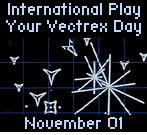Jay Smith
| Jay Smith | |
| Head of | Smith Engineering and Western Technology |
| Distributors | Bandai GCE Milton Bradley and others |
In 1979, Jay Smith designed Milton Bradley's Microvision, which was the world's first handheld system to use cartridges. The compact design was incredibly innovative, featuring game cartridges that contained their own micro processors and overlays. Though the world wasn't quite ready for the Microvision, the concept of independent, portable game systems and exchangeable screen overlays would experience a rebirth of sorts in Mr. Smith's next innovation, as he would become known as the "Father of the Vectrex".
Smith, together with his companies of Western Technologies and Smith Engineering, gave birth to the idea for a "mini-arcade" in the early eighties, initially envisioned with a 5-inch monitor. The development of the Vectrex started with an idea from staffers (probably Mike Purvis and John Ross) after brainstorming about how to use cheap CRT Displays that were found in a small liquidators' surplus store. The idea took flight and form under the skilled cultivation of Jay Smith, guiding his talented staff.
In 1981, Smith presented the concept of the "Mini Arcade" - a self-contained game system featuring vector graphics and its own 5" monitor. The idea was initially pitched to Kenner but it was rejected. A few tweaks to the design - most notably a bigger, 9" monitor - attracted another company, General Consumer Electronics (GCE). Known because of it's game and watches, GCE was enthusiastic and wanted to cooperate with Smith, on condition that a bigger monitor would be used.
And that's how, after code names like HP-3000 and Vector-X, the Vectrex with a 9-inch CRT Display was born. Manufacturing of the newcomer among the game consoles started in the summer of 1982, and in November the first Vectrex consoles appeared in American stores. Now, for $199, the consumer could create their own arcade.
Jay Smith's son Spencer Smith was the first official Vectrex game Beta tester. Every Vectrex GCE game was produced only if he had played the game and liked it.
Canadian and overseas distribution of the Vectrex began in 1983 by Milton Bradley, along with Bandai handling distribution of the system in Japan (under the name of Bandai Vectrex Kousokusen).
Unfortunately several factors killed off the Vectrex rather quickly, one being the Video Game Crash of 1983-1984. Also, with Milton Bradley distributing the Vectrex, they were looking to be bought out by Hasbro. Hasbro was convinced that video games were a fad, so the Vectrex television commercials were withheld from any further airplay. In order to try to make the Vectrex more competitive, the price of the unit was slashed repeatedly (from $150 U. S., to $100, then $50), but the Vectrex never saw a profit (losing over $30 million altogether), which ended up being canceled in 1984.
In 1988, Jay Smith envisioned bringing back the Vectrex as a handheld unit, but the $100 price tag was deemed to be too high, so it was canceled. All Vectrex rights were reverted back to Jay Smith, who deemed free, legal distribution of Vectrex ROMs and materials (as long as they were not sold for a profit), and in On October, 1993, a feature about the 10th anniversary of the Vectrex was published in the German "Video Games" magazine. It contained technical descriptions, pictures of Jay Smith and Mark Indictor, a Vectrex history and a list of games and accessories. The article is based on information collected by the author Stefan Herr from the Usenet Vectrex newsgroup, various FTP archives, many emails from several former Vectrex developers and a historical overview about the development by Jay Smith. (Source: Vectrex FAQ 5.2)
Then in 1995, a rebirth of the Vectrex came with the first edition of the Sean Kelly Multicart, followed by Vector Vaders, the first Vectrex homebrew ever, which has since been followed by dozens of other games to date.
Contents |
Trivia
During the RetroGaming Roundup 2010 Podcast, with all the involvement Smith has had with video games for decades, he was asked what his all-time favorite product was. He said it was the Vectrex, as it was one of his “favorites of all time”.
Interview
Listen to a 45 minute interview with Jay Smith talking about Vectrex, Colour Vectrex, Microvision, Buzz Aldrin, etc.
With the entertaining fellows at RetroGaming Roundup Podcast. :
Timetable of Inventions
| Inventions by Jay Smith (Product lifespan) | ||||||||||||||||||||||||||||||||||||||||||||
|---|---|---|---|---|---|---|---|---|---|---|---|---|---|---|---|---|---|---|---|---|---|---|---|---|---|---|---|---|---|---|---|---|---|---|---|---|---|---|---|---|---|---|---|---|
| 1979 | 1980 | 1981 | 1982 | 1983 | ||||||||||||||||||||||||||||||||||||||||
| O | N | D | J | F | M | A | M | J | J | A | S | O | N | D | J | F | M | A | M | J | J | A | S | O | N | D | J | F | M | A | M | J | J | A | S | O | N | D | J | F | M | A | M | J |
| Work in progress... | ||||||||||||||||||||||||||||||||||||||||||||
| Microvision Handheld (Milton Bradley) |
||||||||||||||||||||||||||||||||||||||||||||
| Vectrex (GCE, MB) |
||||||||||||||||||||||||||||||||||||||||||||
References
- computermuseum.50megs.com
- digitpress.com
- vectrexmuseum.com - Vectrex FAQ version 5.2
Links
Jay Smith Interview – (from the 88 to 135 minute mark; right click on the link to download the .mp3 from www.retrogamingroundup.com)

